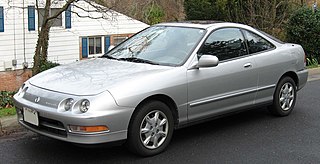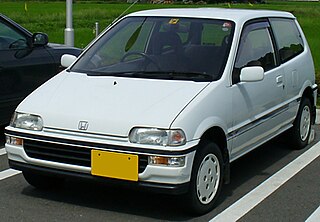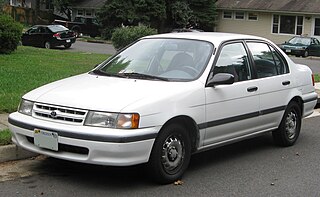Related Research Articles

A carburetor or carburettor is a device that mixes air and fuel for internal combustion engines in an appropriate air–fuel ratio for combustion. The term is sometimes colloquially shortened to carb in the UK and North America or to carby in Australia. To carburate or carburete means to mix the air and fuel or to equip with a carburetor for that purpose.

The VAZ-2108, known as the Lada Samara in much of Western Europe, is a series of small family cars produced by Soviet/Russian vehicle manufacturer AvtoVAZ under the Lada brand between 1984 and 2013. The model name Samara originally was used only for exported models, in the Soviet Union the same model was called Sputnik until 1991, when the sedan version of the Samara entered in production, using the export name. It was the first front-wheel drive serial car built in the Soviet Union after the LuAZ-969V. The Samara had been modified and restyled during the years of production before it was finally discontinued in December 2013.

A vehicle identification number (VIN) is a unique code, including a serial number, used by the automotive industry to identify individual motor vehicles, towed vehicles, motorcycles, scooters and mopeds, as defined in ISO 3779 and ISO 4030.

A vehicle registration plate, also known as a number plate, license plate, or licence plate, is a metal or plastic plate attached to a motor vehicle or trailer for official identification purposes. All countries require registration plates for road vehicles such as cars, trucks, and motorcycles. Whether they are required for other vehicles, such as bicycles, boats, or tractors, may vary by jurisdiction. The registration identifier is a numeric or alphanumeric ID that uniquely identifies the vehicle or vehicle owner within the issuing region's vehicle register. In some countries, the identifier is unique within the entire country, while in others it is unique within a state or province. Whether the identifier is associated with a vehicle or a person also varies by issuing agency. There are also electronic license plates.

The Honda Integra, marketed in North America as the Acura Integra, is an automobile produced by Japanese automobile manufacturer Honda from 1986 to 2006. It succeeded the Honda Quint as a more luxurious and sport-oriented derivative of the Civic. The Integra was one of the launch models for Acura in the US in 1986 alongside Acura Legend. Throughout its life, the Integra was highly regarded for its handling and performance. The Integra Type R is widely regarded as one of the best front-wheel-drive cars of all time.

The Ford Laser is a compact car, originally a subcompact car in the first three generations, which was sold by Ford in Asia, Oceania, and parts of South America, and Africa. It has generally been available as a sedan or hatchback, although convertible, wagon and pick-up versions have also been available in different markets. The sedan, and briefly station wagon, versions were badged Ford Meteor in Australia between 1981 and 1987. The Ford Meteor name was also used in South Africa.

The Ford Orion was a small family car that was produced by Ford Europe from 1983 until 1993. A total of 3,534,239 units were sold during the car's ten-year production life.

The Zenith Carburetter Company Limited was a British company making carburettors in Stanmore Middlesex, founded in 1912 as a subsidiary of the French Société du carburateur Zénith. In 1965, the company joined with its major pre-war rival Solex Carburettors, and over time, the Zenith brand name fell into disuse. The rights to the Zenith designs were owned by Solex UK.

The Geo Metro was a marketing and manufacturing variation of the Suzuki Cultus available in North America from 1989 through 2001 as a joint effort of General Motors (GM) and Suzuki. In the US, the Metro carried a Geo nameplate from 1989 through 1997, and a Chevrolet nameplate from 1998 to 2001. It evolved with the Cultus and its siblings over 13 years, three generations and four body styles: three-door hatchback, four-door sedan, five-door hatchback and two-door convertible—and was ultimately replaced in the General Motors lineup by a family of vehicles based on the Daewoo Kalos.

The Honda Today was a kei car (minivehicle) produced by the Japanese automaker Honda beginning in 1985. It was replaced by the Honda Life in 1998. Honda's smallest car being produced at the time was the Honda City, which was a supermini and it had an engine larger than kei car legislation allowed. The Today represented a reentry into kei car production. Honda had abandoned kei passenger cars in 1975, choosing only to keep manufacturing the Honda Acty kei truck and the related Honda Street microvan in that segment. After 1975, Honda's smallest car was the Honda Civic, until the introduction of the smaller Honda City in 1981.

The Suzuki Cultus is a supermini car produced by the Japanese manufacturer Suzuki from 1983 to 2003, and it is now a rebadged Suzuki Celerio in Pakistan since 2017. It was first presented at the 25th Tokyo Motor Show, formally introduced to Japan in 1983 and ultimately sold in seven countries across three generations and marketed worldwide as the Suzuki Swift for the first two generations. An alliance formed in 1981 between GM and Suzuki allowed GM to market the Cultus as a captive import internationally under more than a dozen nameplates including the Geo Metro, Chevrolet Sprint, Pontiac Firefly and Holden Barina. It was also known as the M-car within GM.
A vehicle registration plate, also known as a number plate, license plate or licence plate, is a metal or plastic plate or plates attached to a motor vehicle or trailer for official identification purposes. The registration identifier is a numeric or alphanumeric code that uniquely identifies the vehicle within the issuing authority's database. In Europe most countries have adopted a format for number plates that satisfies the requirements in the Vienna Convention on Road Traffic, which states that cross-border vehicles must display a distinguishing code for the country of registration on the rear of the vehicle. This sign may be an oval sticker placed separately from the registration plate, or may be incorporated into the vehicle registration plate. When the distinguishing sign is incorporated into the registration plate, it must also appear on the front registration plate of the vehicle, and may be supplemented with the flag or emblem of the national state, or the emblem of the regional economic integration organisation to which the country belongs. An example of such format is the common EU format, with the EU flag above the country code issued in EU member states.

The Toyota Tercel is a subcompact car manufactured by Toyota from 1978 to 1999 across five generations, in five body configurations sized between the Corolla and the Starlet. Manufactured at the Takaoka plant in Toyota City, Japan, and sharing its platform with the Cynos and the Starlet, the Tercel was marketed variously as the Toyota Corolla II — sold at Toyota Japanese dealerships called Toyota Corolla Stores — and was replaced by the Platz in 1999. It was also known as the Toyota Corsa and sold at Toyopet Store locations. Starting with the second generation, the Tercel dealership network was changed to Vista Store, as its badge engineered sibling, the Corolla II, was exclusive to Corolla Store locations.

Weber is an Italian company which produces carburetors; it is owned by LCN.
A standardized automobile model numbering system has been used in the Soviet Union and Russia. Using the modern version of the system it is possible to determine a vehicle's type and engine capacity. The modern version of the numbering system was introduced in the mid-1970s. A similar system is used in the People's Republic of China.
In the United States, the appearance of license plates is frequently chosen to contain symbols, colors, or slogans associated with the issuing jurisdiction, which are the 50 U.S. states, the District of Columbia, the 5 inhabited U.S. territories, and Native American tribes, each of which independently registers motor vehicles. Regular-issue license plates for passenger vehicles typically have 5-7 characters, with specialty or vanity plates having up to 8 characters in some states. This article describes the designs and serial formats for regular-issue plates.

In 1987, the Honda Civic was significantly redesigned for model year 1988. The suspension had a radical re-configuration with double wishbone suspension in the front and an independent suspension in the rear, wheelbase was increased to 98.4 inches (250 cm), and the body was redesigned with a lower hood line and more glass, giving less drag. The front suspension incorporates an extended hub carrier, so the upper arm is relatively short. The rear suspension is a multi-link trailing arm suspension with upper and lower lateral control links near the axle line and a short lateral link for toe control ahead of the pivot of the main trailing arm.

The sixth generation Honda Civic was introduced in 1995 with 3-door hatchback, 4-door sedan and 2-door coupe body styles, replicating its predecessor's lineup. A 5-door hatchback was also produced to replace the Honda Concerto hatchback in Europe but this model, while using the same design language as the rest of the Civic range, was quite distinct, instead being a hatchback version of the Honda Domani, sharing that car's platform which was related to the fifth-generation (EG/EH/EJ) Civic. The Domani replaced the sedan version of the Concerto in Japan while the sedan version of the Concerto was directly replaced by the sixth generation Civic sedan in other markets. Two wagons were also made available; the JDM Orthia, based on the Civic sedan/3-door hatchback line, and a 5-door hatchback/Domani-based model, sold as the Civic Aerodeck, in Europe. Neither were offered in North America. The Civic 5-door hatchback also formed the basis for the 1995 Rover 400 although the 4-door sedan version of the Rover was quite distinct from the Domani.

The Honda Vigor is a premium sedan that was derived from the Honda Accord. It was sold in Japan through the Honda Verno dealer network from 1981 to 1995, and sold in North America from June 1991 to 1994 as the Acura Vigor. Early Vigors were more upmarket versions of the Accord, and served as Honda's flagship until the arrival of the Honda Legend. In 1989, the Vigor would differentiate itself further from the Accord with unique styling and an available longitudinal five-cylinder engine, and a twin to the Vigor was introduced with the Honda Inspire, available at Honda Clio dealerships.

SU carburettors were a British manufacturer of constant-depression carburettor. Their designs were in mass production during most of the twentieth century.
References
- ↑ Maxim Product Naming Conventions
- ↑ Logic product naming conventions
- ↑ "Nokia naming conventions". Archived from the original on 2010-03-06. Retrieved 2011-06-16.